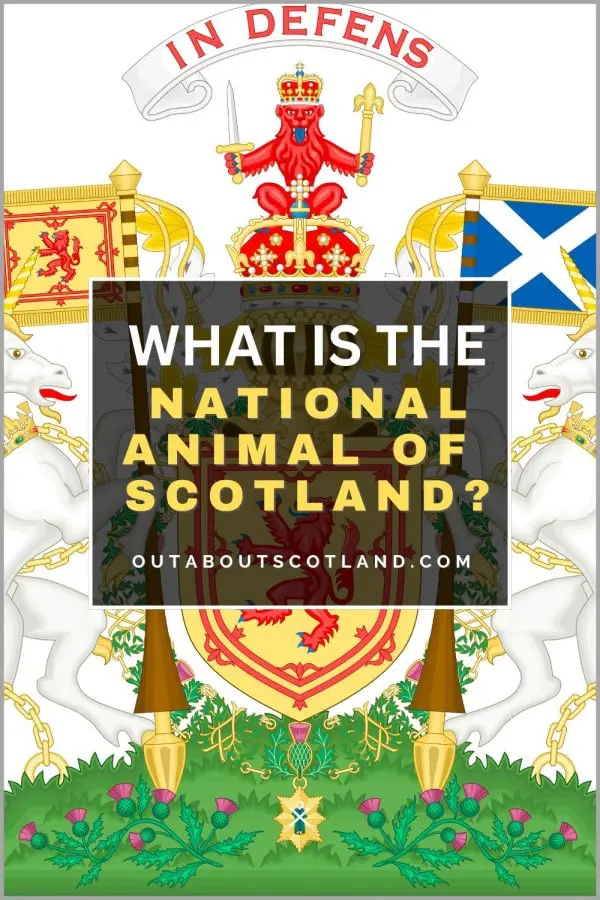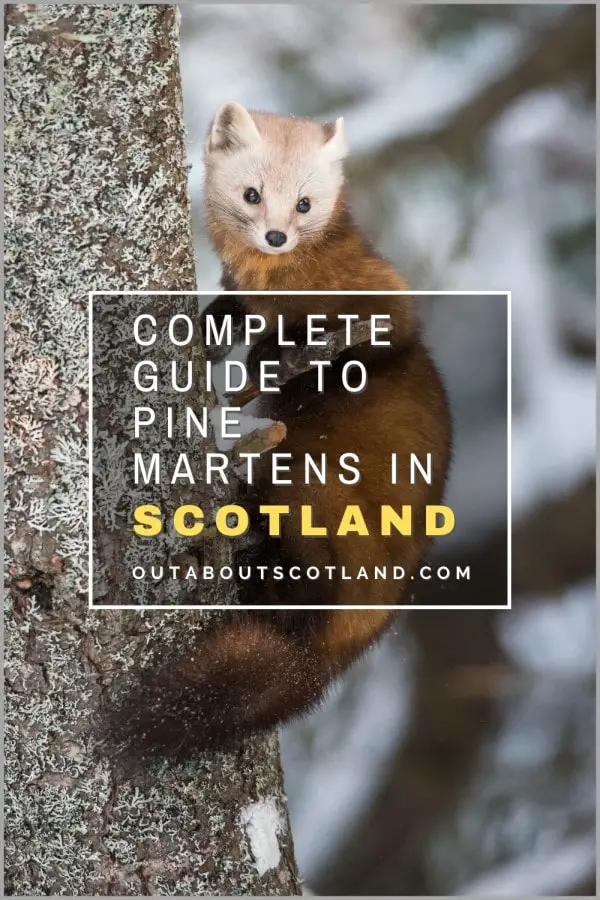Red squirrels may be declining in other parts of the UK, but here in Scotland we have healthy—and even growing—populations that see estimates of 120,000 animals in our coniferous forests and broadleaved woodlands. Discover exactly where red squirrels live, what you can feed them, and the threats they’re currently facing in this ultimate guide to where to see red squirrels in Scotland.
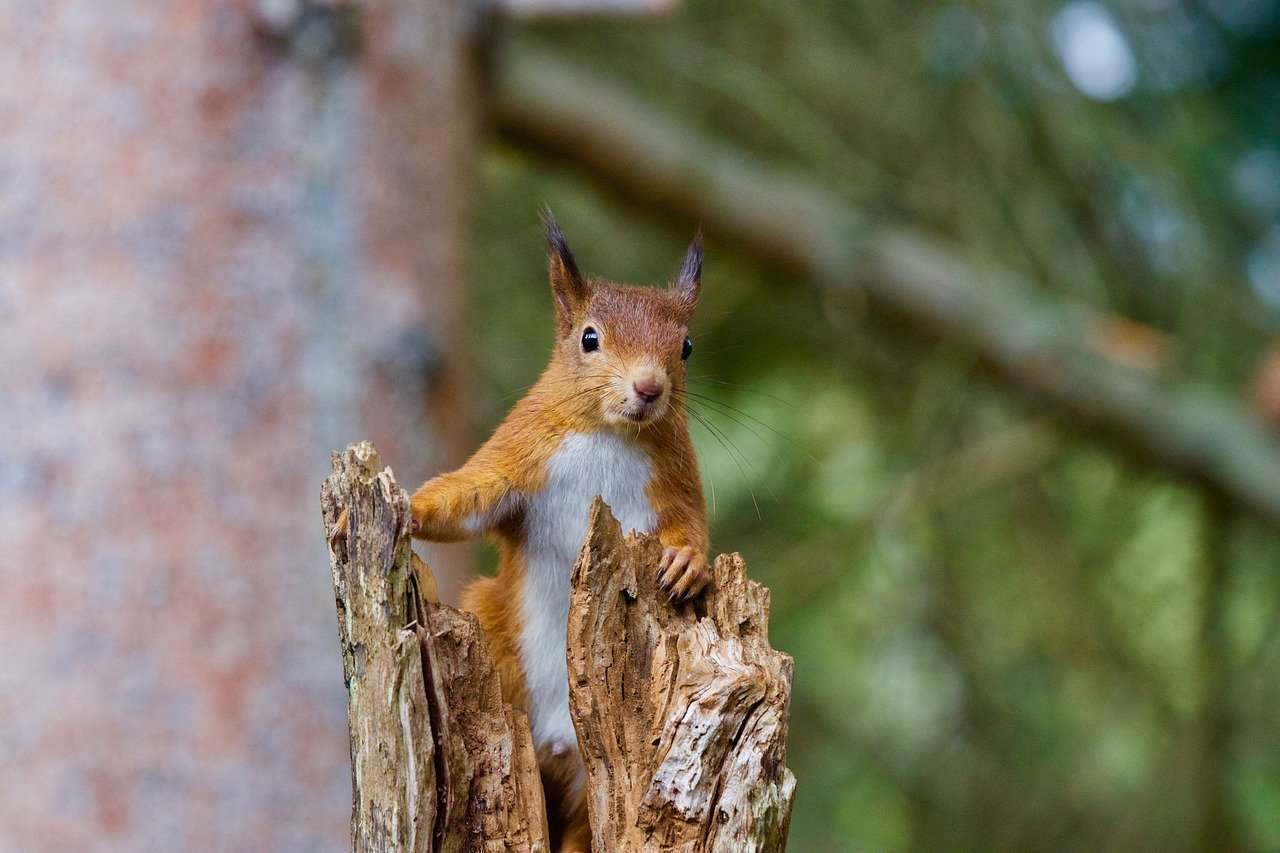
Where to See Red Squirrels in Scotland
While red squirrels live in most countries throughout Northern Europe, it’s a sad fact that their numbers are dwindling apart from a few strongholds like Scotland, where their populations are steady and, in some areas, even growing.
The sight of red squirrels scurrying about amongst the branches of a Scots pine has to be one of the highlights of a visit to Scotland’s forest parks, but sadly the main reason why they’re so prevalent in the far north of Britain is that most of the UK’s woodlands south of the border have been cut down in the last hundred years.
Deciduous woodlands are actually their preferred home, as broadleaved trees offer a greater variety of foods, and while there are still a few areas in England that have pockets of red squirrels – Northumberland and Yorkshire, for example – the majority of the population is being pushed further and further north.
Some regions of Scotland are seeing an increase in numbers at a greater rate than others, and Aberdeenshire, in particular, is doing very well at the moment, to the point where they are now as likely to be seen in town parks and gardens as they are in conifer forests.
So, where are you most likely to see red squirrels? Well, the pine forests of the Highlands, Dumfries, and Galloway have healthy populations, as does the Isle of Arran, but there’s every chance you’ll see them in these forest areas as well.
- Glen Affric, west of Loch Ness, Highlands.
- Glenmore Forest Park near Aviemore, Highlands.
- Bennachie near Inverurie, Aberdeenshire.
- Garbh Eilean, south of Glenfinnan, Highlands.
- Glen Righ, south of Fort William.
- Queen Elizabeth Forest Park, north of Aberfoyle.
- Kirroughtree, west of Newton Stewart, Galloway.
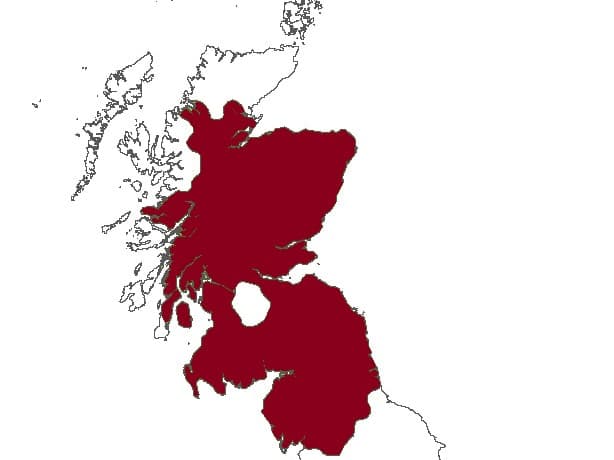
Basically, if you visit any of the forested areas of Scotland you’ve got a good chance of seeing red squirrels, but like any wild animal they like to roam around – and Scotland has plenty of space for them to do so.
My advice, therefore, is to head into the great outdoors and hope for the best because even if you don’t catch sight of a red squirrel you might be lucky enough to see other native animals that Scotland is famous for like red deer, grouse, golden and sea eagles, seals, dolphins, and thanks to a re-introduction programme – beaver.
Protect Your Family From Scotland's Biting Midges
- Powerful, reliable protection for up to 8 hours
- Water- and sweat resistant
- Repels midges, mosquitoes, horse flies, sand flies, fleas and ticks
- Safe for use on adults, children over 30 months and pregnant women
- Non-sticky, moisturising with a pleasant fragrance
- Packaging may vary
Where Are the Main Forest Parks in Scotland?
If you didn’t already know, there are six main forest parks in Scotland which are Glenmore, Argyll, Galloway, Tweed Valley, Queen Elizabeth and Tay, and all of them are worth visiting whether you want to go on a wildlife-spotting trek or just enjoy hiking through forest trails.
You’ll find a map further down but I’ll go into a quick overview of each forest park here.
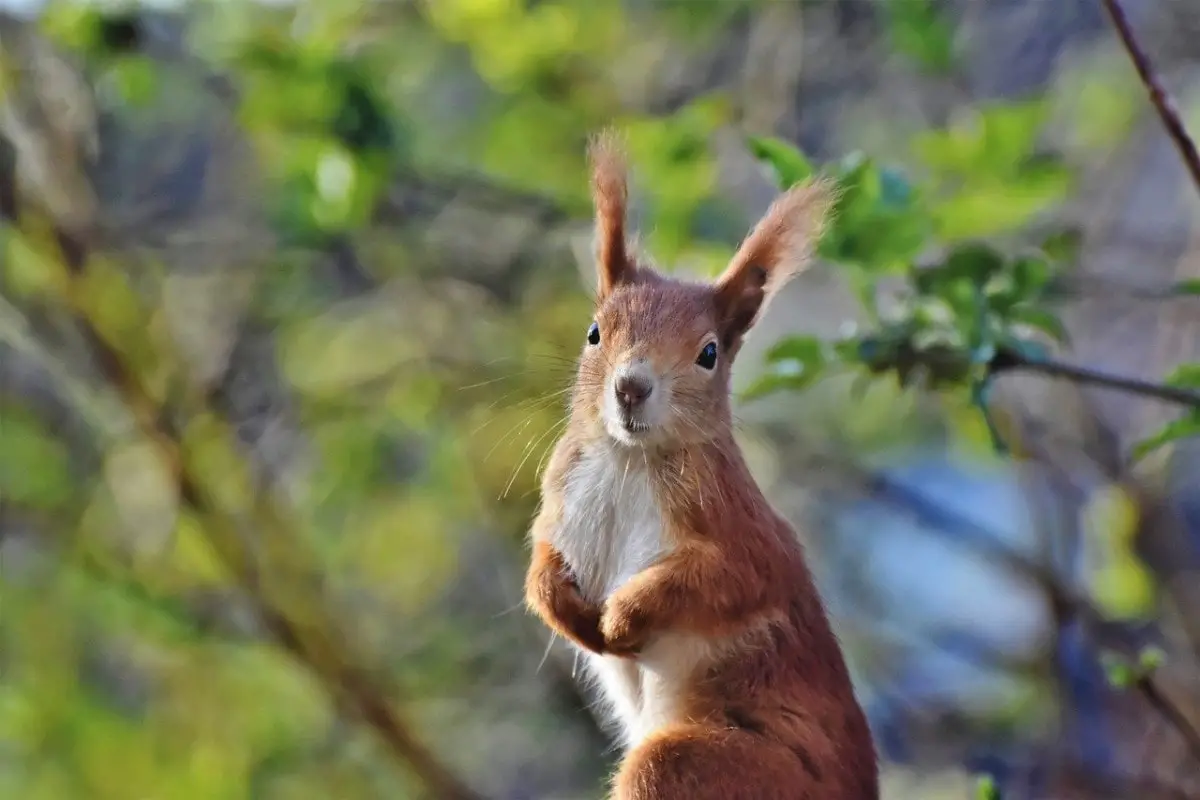
Glenmore Forest Park: Located in the heart of the Cairngorms, a large part of Glenmore Forest Park is a designated National Nature Reserve. One of the highlights is Loch Morlich which is a stunning freshwater loch surrounded by forest with a golden sand beach at one end.
Argyll Forest Park: This is Britain’s oldest forest park having been founded in 1935. It covers a vast area that stretches from the Firth of Clyde to the Arrochar Alps and because it’s so close to Glasgow it’s easy to combine a visit with Loch Lomond.
Galloway Forest Park: Galloway Forest is located midway between Dumfries and Stranraer in the southwest of Scotland. The forest is famed for its network of walking and mountain biking paths and it’s also one of the few official dark skies parks in Britain where there is hardly any light pollution.
Tweed Valley Forest Park: This is one of the smaller forest parks in Scotland but as it’s less than an hour away from Edinburgh it’s very popular with cyclists who want to get away from the hubbub of the city. One particular highlight is Cardrona forest which has mile after uninterrupted mile of superb woodland walks.
Queen Elizabeth Forest Park: One of the largest forest parks, Queen Elizabeth Park stretches from Loch Lomond across the rolling Trossachs to the pretty country town of Callander and further north to Strathyre. The park encompasses all the best features of the other parks with lots of walking trails, lochs and mountains.
Tay Forest Park: Perthshire is also called ‘big tree country’, and with good reason. Some of Scotland’s oldest natural woodlands are found in this area and the views everywhere you go are nothing short of breathtaking, from Faskally near Pitlochry to the Queen’s view – one of Queen Victoria’s favourite beauty spots.
- Argyll Forest Park
- Galloway Forest Park
- Glenmore Forest Park
- Tay Forest Park
- Tweed Valley Forest Park
- Queen Elizabeth Forest Park
Grey Squirrels vs Red Squirrels
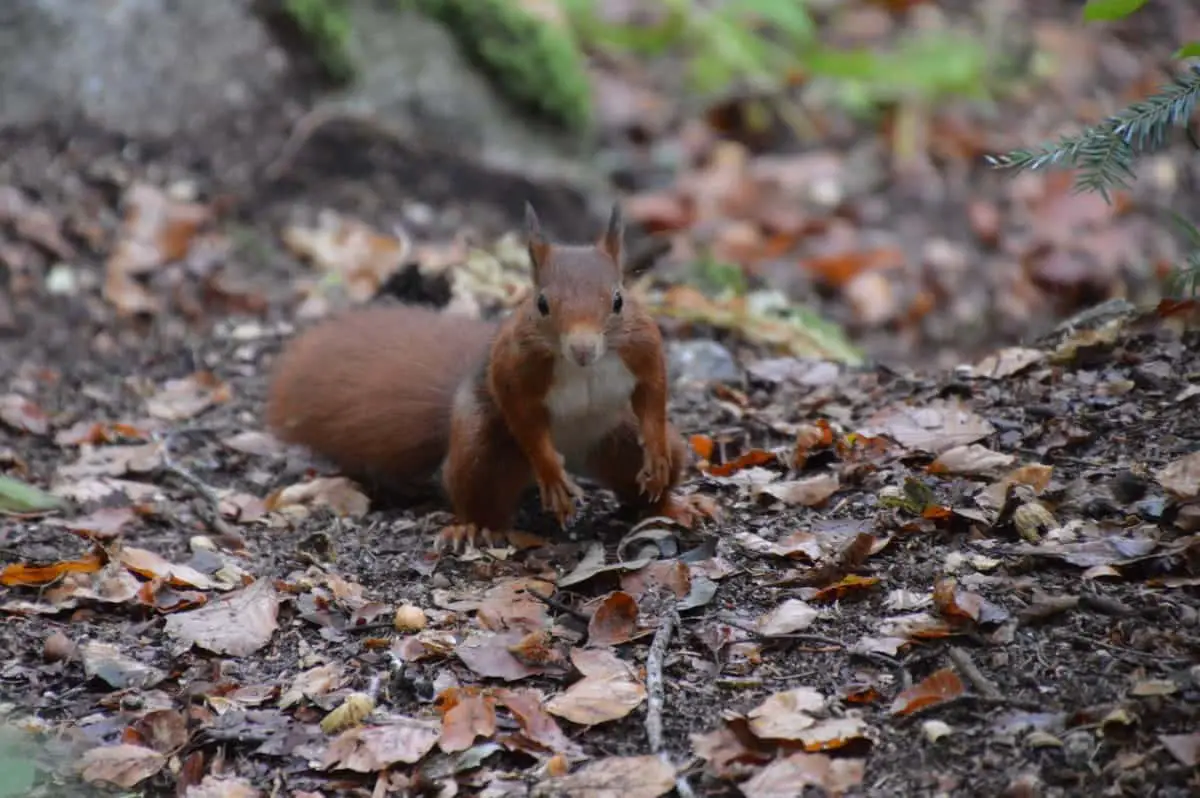
Red squirrels are a type of small rodent that live primarily in trees. Although there are several different species of squirrel, the one we’re concerned with here is the Eurasian red squirrel which is smaller and less hardy than its more prevalent cousin, the eastern grey squirrel.
Grey squirrels are not native to Scotland and were introduced in the 20th century as ornamental garden animals. They have since become a common sight in many parts of the country – especially in urban and suburban areas – and their numbers are currently estimated at 200,000 individuals.
They are known for their agility and intelligence and are often seen climbing trees and foraging for food. However, they can also cause damage to trees and gardens and have been known to compete with native red squirrels for food and habitat.
If you’ve ever seen a red squirrel you’ll know there’s quite a size difference between them and greys. While grey squirrels average 25 to 30 cm from nose to backside and weigh a portly 400 to 800 grams, reds come in at a featherweight 250 to 340 grams and have a teeny-tiny combined head and body length of 19 to 23 cm.
The two species aren’t known to be aggressive to each other but if there ever was a round of fisticuffs between them the reds would probably come second best.
What reds have on their side is an adaptability that allows them to survive throughout Scotland’s coldest regions and they’re even able to thrive in the remote Highlands where many other animals would struggle to last through our desperately long and cold winters.
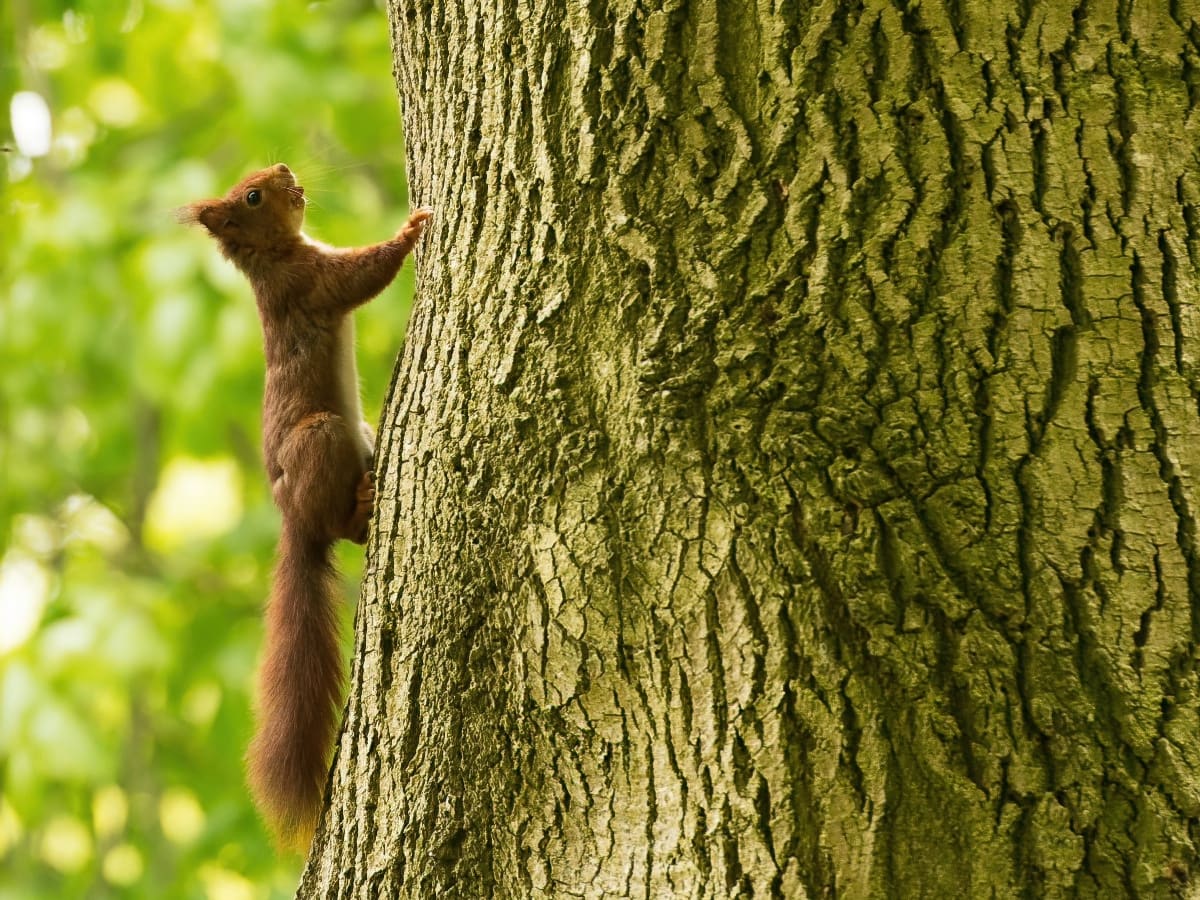
That is in no small part thanks to their famously tufty tail which they wrap around themselves to retain body heat when temperatures plummet. Those tails add an extra two-thirds to their body length and with an average length of 15 to 20 cm they’re able to almost completely wrap themselves up in their own fluffy mobile sleeping bag.
Another use for the tail is as a balance when jumping, and red squirrels are famous for their acrobatics when moving from tree to tree. Just like grey squirrels, reds are primarily arboreal which means they spend most of their time in trees and only occasionally come down to ground level to look for nuts and seeds which is their main food source.
They’re quite skittish animals as you’ll know if you’ve ever accidentally made a noise while watching one and they can scamper up tree trunks in a flash thanks to their sharp curved claws and strong hind legs. The impressive claws evolved because they prefer to live amongst pine and spruce trees which generally have less low-level branches than the broadleaved trees you’ll find south of Scotland.
The other distinguishing feature is of course their red coat and contrasting white belly. The coat actually changes colour slightly between summer and winter with the summer months producing a thinner and redder coat compared to the dense dark red coat and large ear tufts they grow in the colder months.
Book Tours in Scotland
What Do Red Squirrels Eat?

In the wild, red squirrels are opportunistic and will eat a variety of foods. Their preferred diet depends on the time of year, with plant shoots and flowers being their main source of nutrition in spring, and nuts, fruit and pine cone seeds comprising the bulk of their diet in autumn and winter.
Surprisingly, the one time of the year when red squirrels might struggle to find enough food to eat is in the summer. Because their favourite foods aren’t readily available between June and August you may find your garden sees more furry visitors in summer than at other times of the year.
If you want to feed red squirrels the best advice is to offer them a mix of different high-energy foods that include sunflower seeds, unsalted peanuts and hazelnuts (preferably in their shells to help keep their teeth healthy). A good ratio would be 4 parts peanuts to 1 part sunflower seeds with a handful or two of hazelnuts thrown in for good measure.
If you have trouble getting hold of hazelnuts red squirrels will happily munch away on beechnuts, chestnuts and pine nuts and they’ll also merrily eat apples, carrots, green beans and celery.
Adding bone meal to their usual diet of nuts and seeds will help prevent them from having a calcium deficiency but you can give them an easy-to-find alternative by placing a cuttlefish bone (like the ones given to pet birds) near their feeder. Speaking of which, when feeding red squirrels you should ideally place their food in a raised squirrel feeder placed high up on a tree.
This serves two purposes, the first being that it prevents cats from grabbing them while they’re preoccupied on the ground and the second that it encourages them to leave your wild bird feeders alone. You’ll know how ingenious squirrels are at raiding bird feeders if you’ve ever seen the YouTube garden obstacle courses that people put up to test squirrels’ intelligence.
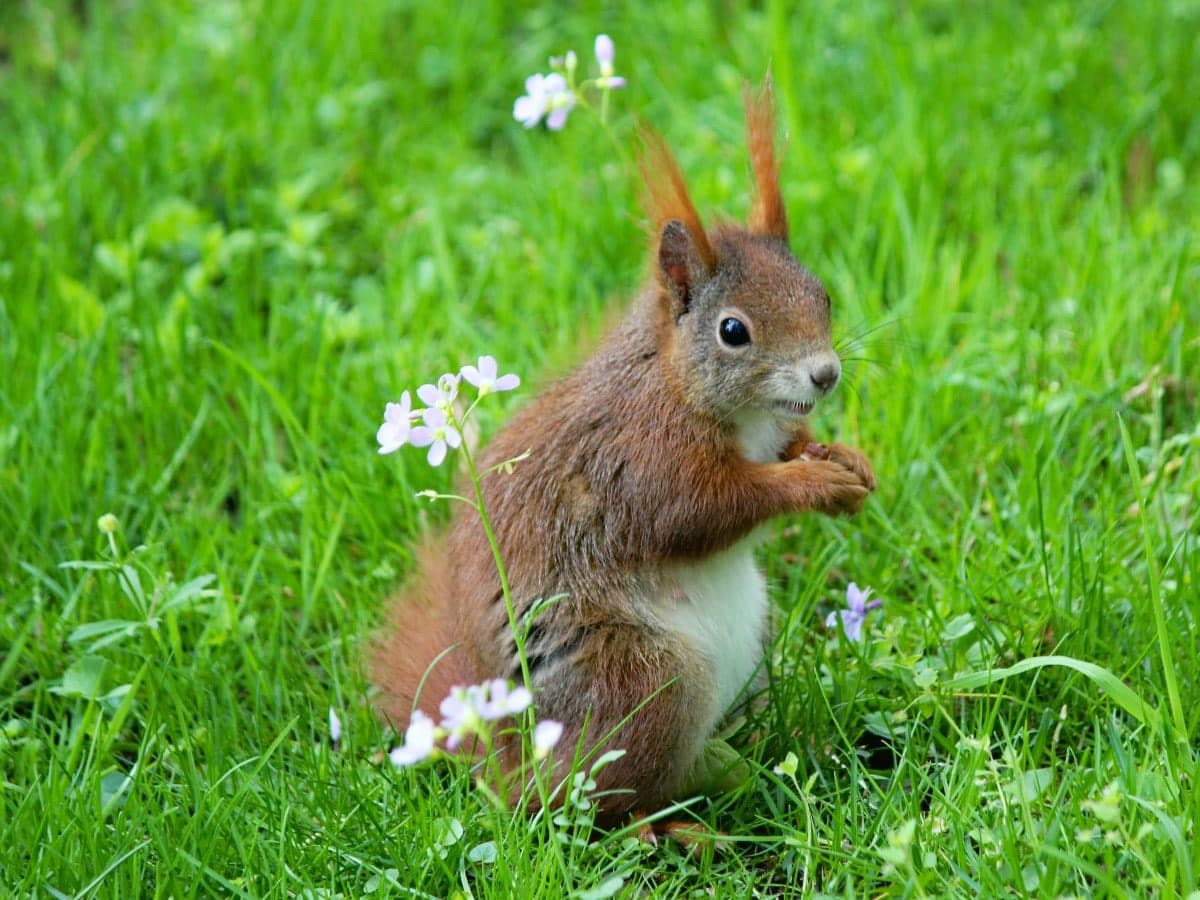
If you’re planning to install a feeder give some thought to its placement and whether or not the squirrels will have to cross a road where they might get squashed in the pursuit of all those yummy seeds. In fact, if there’s a road between your garden and woodland, it might actually be in the squirrel’s best interest if you don’t feed them at all.
If it looks like it’s full steam ahead on the squirrel feeder front, it’s best to keep it clean by scrubbing any mouldy food off it at least once a week and preferably using an anti-viral detergent like this one from Amazon that will limit the transmission of squirrel pox (more on that below).
Finally, squirrels, like every other animal, will become dependent on the food you leave out in your garden if they start to think they don’t need to look elsewhere. That is a bad situation to be in as they will eventually end up going hungry if you go on holiday or move house.
To get around the problem, it’s advisable to feed red squirrels every 3 to 4 days instead of every day so that they get enough food to keep them going when their natural supplies are low but also retain the instinct to forage in the wild.
Bear in mind they’ll likely stop feeding from your garden in autumn and spring as all those juicy shoots and seeds will be in abundance, but giving them a helping hand in summer and the depths of winter certainly won’t do any harm.
How Do Red Squirrels Nest?
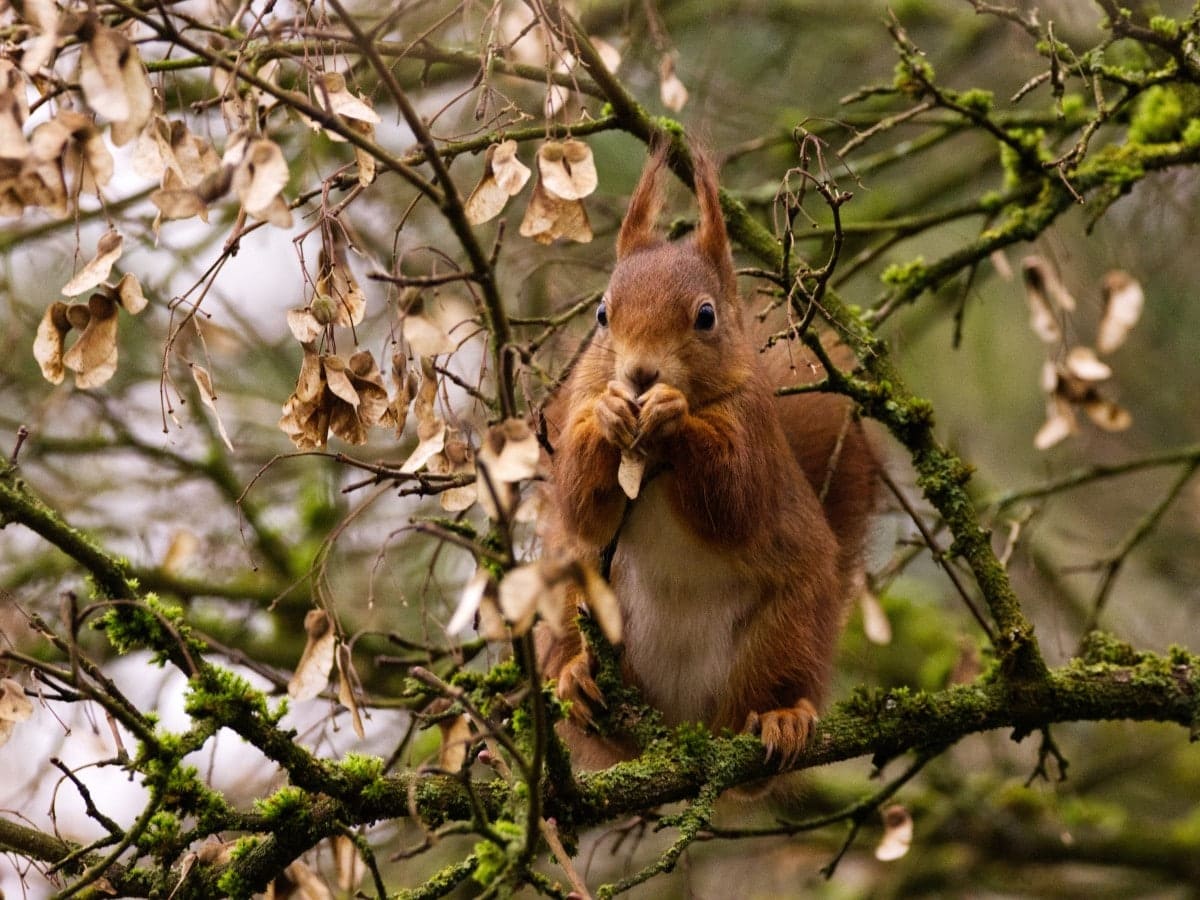
You could be forgiven for thinking red squirrels hibernate during Scotland’s long winters but in fact, they don’t hibernate at all and they’re active throughout the year. Being arboreal they spend most of their lives in treetops and that includes where they sleep.
Red squirrels like to build nests two-thirds of the way up a tree – at least 6 metres off the ground – and high enough to keep them safe from ground-level predators but not so high they make easy picking from any birds of prey that might be circling overhead.
These nests are known as ‘dreys’, and they’re usually found in the forks of two large branches. If you see one, you’ll know it’s a squirrel rather than a bird’s nest, as they’re much larger, roughly the size of a football with an opening about the size of a grapefruit.
Each drey is made from a collection of twigs and branches that the squirrel pushes together into a fairly dense ball and they’re almost always lined with a thick layer of leaves, moss and fir. Occasionally, they won’t bother with making a drey if they find a suitable hollowed-out knot in a tree as these prove to be more waterproof than an exposed nest made from twigs.
Rather cunningly, squirrels almost always make 2 dreys, one as their main nest and one as a backup in case the main one gets found by predators or becomes waterlogged.
They also like to have a summer drey and a winter drey, with the summer home offering less overhead protection and the winter version having a much thicker lining, but if either becomes too damaged they will abandon it entirely and make a new one elsewhere.
Protect Your Family From Scotland's Biting Midges
- Powerful, reliable protection for up to 8 hours
- Water- and sweat resistant
- Repels midges, mosquitoes, horse flies, sand flies, fleas and ticks
- Safe for use on adults, children over 30 months and pregnant women
- Non-sticky, moisturising with a pleasant fragrance
- Packaging may vary
When Do Red Squirrels Have Babies?
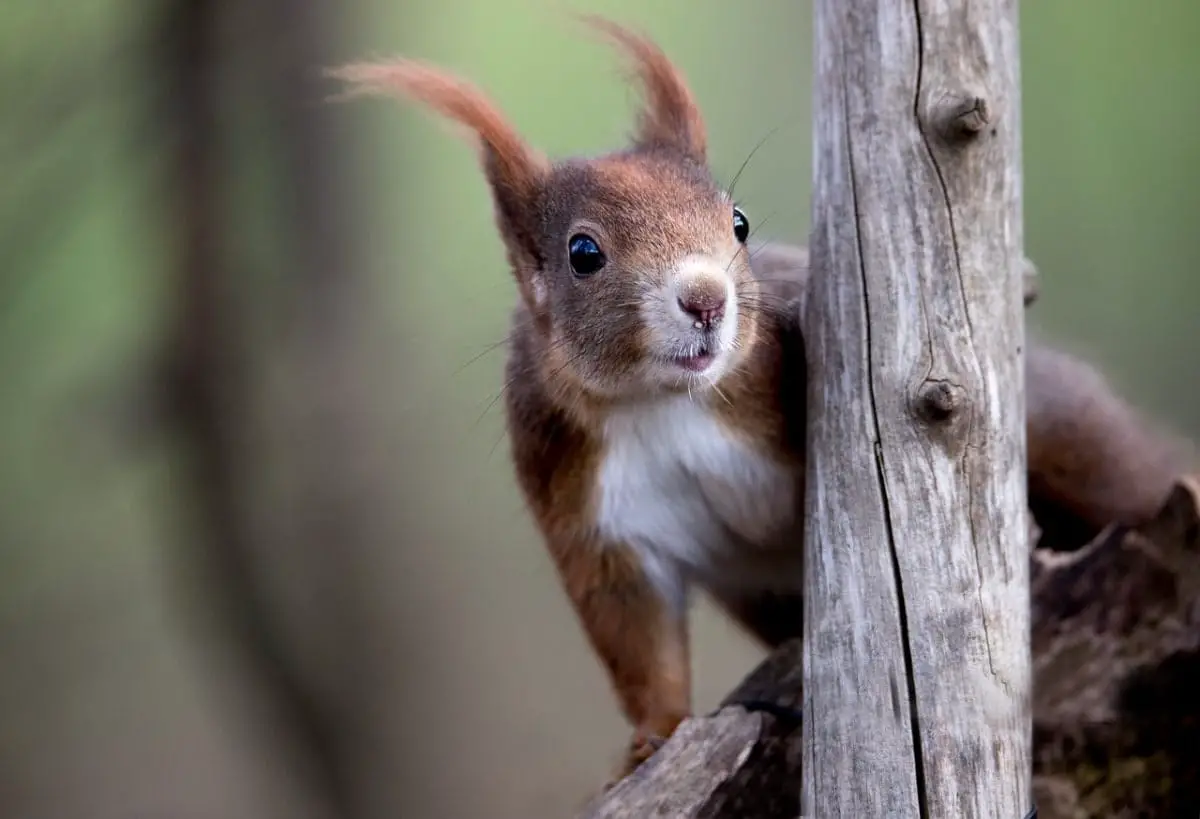
Breeding season in Scotland usually starts in January and ends in March depending on how good or bad the weather is but on the whole, red squirrels will start mating in January. The gestation period of reds is slightly shorter than that of greys, at 38 days compared to 44 days, so it’s usual for a mother to have her first litter of the year sometime in March. The babies, correctly termed ‘kittens’, stay in the drey for around 7 weeks before weaning begins at 10 weeks.
One reason why greys are overtaking our native-born reds is their litters are usually much larger with up to 8 kittens compared to just 3-4 in a typical red squirrel brood, although red squirrels do typically live longer at an average of 6 years compared to 5 years for greys.
Reds will also have a second litter in the summer if there is a plentiful supply of food, with the next generation usually being born in July and August. The animals from this litter have a double-edged sword, as they will leave the nest to a plentiful supply of nuts and seeds, but they will also have to contend with a freezing winter while they’re still young.
It’s a sad fact that the mortality rate for kittens in their first year can be as high as 50%. If they do manage to survive the winter they will start to reproduce once they’re a year old unless there is a food shortage in which case birth rates drop dramatically until food becomes plentiful again.
What Are the Main Threats to Red Squirrels?
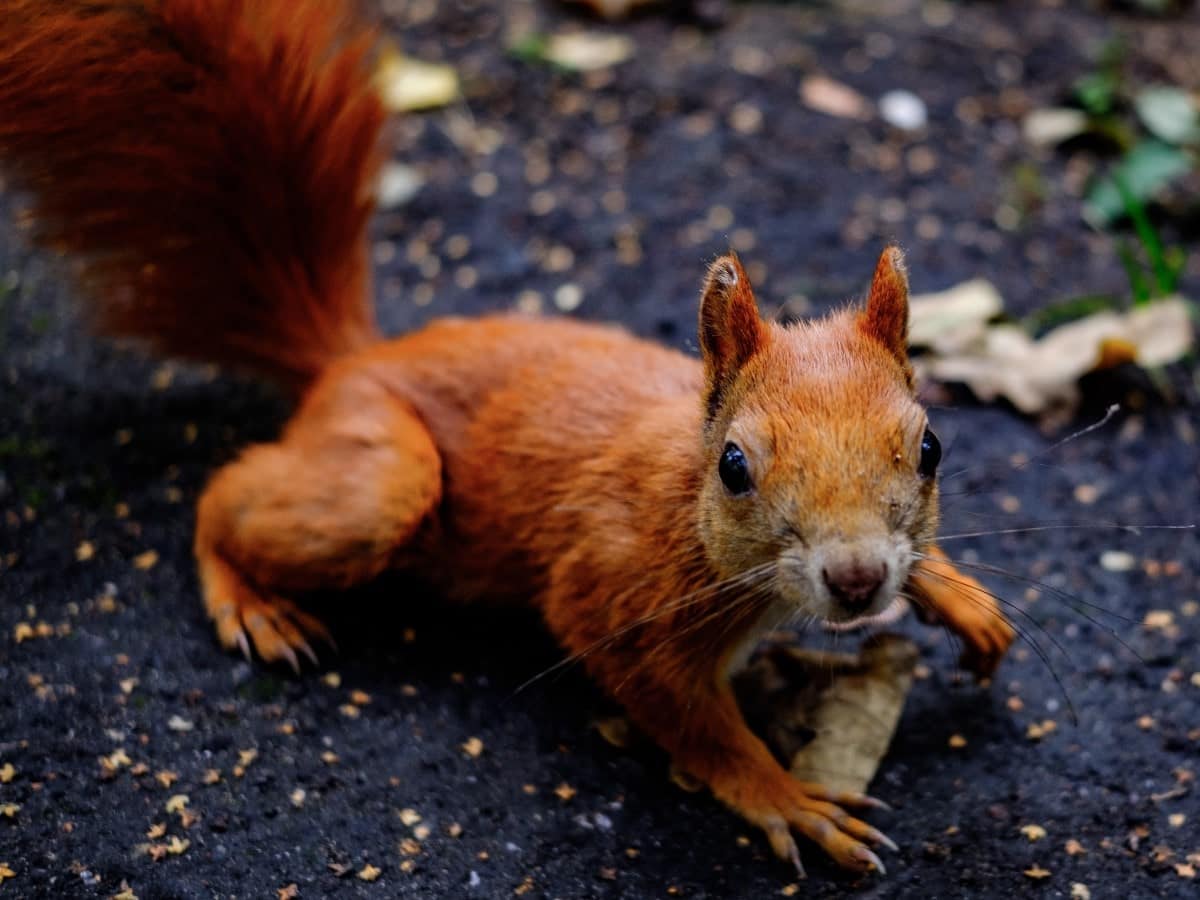
Although red squirrel populations are quite healthy in other parts of Northern Europe, here in the UK they are either at or verging on the endangered list due to several threats, most of which are man-made. The first and biggest factor in the decline of Britain’s red squirrels was the introduction of the invasive American greys in 1876, which were brought over as an ornament for stately homes.
The Victorians had no idea about the damage foreign species could do because just like the rhododendron plant, grey squirrel numbers quickly got out of control and by 1930 they had spread across England to the point where laws had to be introduced to make it illegal to release any more into the wild.
Unfortunately, by then the damage was already done, and now, 90 years later, England has all but lost the battle against grey squirrels. So what, you might be asking, is the problem?
Well, greys are much happier living in dense populations than reds, and it’s quite common for 15 or more animals to live in the same hectare of woodland compared to just 2 to 3 red squirrels. That means there are lots of hungry bellies on the march for food, and coupled with the fact they have a resistance to the tannins found in unripe acorns, grey squirrels can decimate crops of acorns before they ripen into a viable food source for reds.
An even bigger problem caused by greys is the transmission of a disease called squirrel pox. This devastating virus has an incredibly high 100% mortality rate in red squirrels, whereas greys have a natural immunity to it, leading them to be carriers without any ill effects.
Once a red squirrel population is introduced to squirrel pox they will die out at a rate 20 times faster than the grey squirrel invasion would cause on its own and the death is a painful one with symptoms similar to myxomatosis in rabbits. If a red squirrel catches squirrel pox it will inevitably die within two weeks.
If you find a red squirrel with suspected squirrel pox you should contact your nearest SSRS Conservation Officer or email squirrels@scottishwildlifetrust.org.uk who will likely request the body is placed somewhere it cannot be carried off by other animals. They will then arrange for it to be sent for post-mortem to confirm if the cause of death was squirrel pox or not.
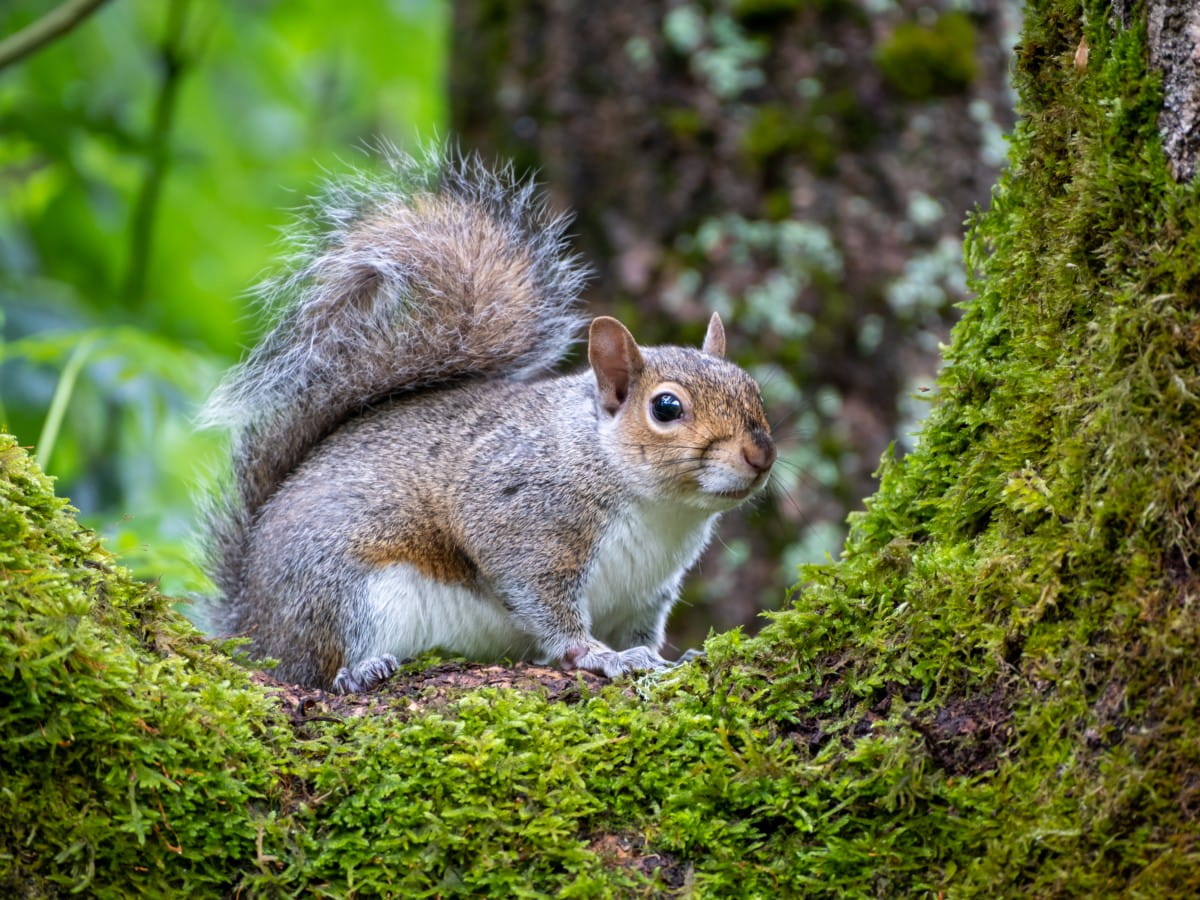
The impact of humans on the environment, primarily the destruction of ancient forests in the constant pursuit of housebuilding and industry, is probably the worst offender (as always) in the decline of red squirrel populations. Vast stretches of woodland have been lost forever in Britain, and the worst hit is England, although Scotland hasn’t fared much better.
Scotland lost the majority of its forest to the timber and shipbuilding industries which came to a head in the early 20th century when only 5% of the country’s forests remained, but thankfully in the last 100 years, some forests were replanted after the 1919 Forestry Act was introduced.
Unfortunately, most of these trees are non-native species that were chosen for their ability to grow quickly rather than their ability to sustain Scotland’s wildlife which has placed even more pressure on our red squirrels. To date, the number of red squirrels in Britain has fallen from 3.5 million to around 120,000-140,000, with 75% of those in Scotland and a mere 15,000 left in England.
Book Tours in Scotland
What Is the Difference Between Red and Grey Squirrels?
| Red Squirrels | Grey Squirrels | |
| Looks | light wheat colour to dark brown coat but predominantly red. Their tufted ears are only visible in winter. They have a white underbelly and a bushier tail than grey squirrels. | Usually silver-grey but occasionally seen to have tinges of red or brown amongst the fur. The tail often has black hairs amongst the grey. |
| Body size (avg) | 19-23 cm | 25-30 cm |
| Tail size (avg) | 17-18 cm | 19-24 cm |
| Weight (avg) | 250-340 gms | 400-800 gms |
| Numbers in UK | 120,000 to 140,000 | Estimates vary between 2.7 million and 3 million |
| Found worldwide | Europe, Siberia, Mongolia and Northwest China. | North America. |
| Threats in the UK | Human destruction of habitat, squirrel pox, loss of food sources to grey squirrels, traffic accidents, natural predators. | Traffic accidents and predators. |
| Conservation status in UK | Classed as endangered in England, Wales and Northern Ireland and near-threatened in Scotland. Protected by the Wildlife and Countryside Act 1981. | Classed as an invasive non-native species. |
Can Red and Grey Squirrels Live Together?
Red and grey squirrels can technically live together but only for a short time due to reasons already outlined – competition for food and the introduction of squirrel pox. While reds spend most of their time up in the trees, greys are busy on the ground hunting for unripe nuts that would otherwise become food for the reds, and in fact, it is this visibility that’s the main reason why grey squirrels were originally introduced to Britain.
Grey squirrels can travel up to 10 miles per day so it’s not really surprising they’ve spread to almost every corner of the country in the last 100 years, although a project to reduce their numbers through humane culling has almost entirely removed them from some parts of Scotland.
There are also ongoing conservation programmes where pine martens have been introduced into areas where grey squirrels live, as these small carnivores are one of the grey squirrel’s main predators. Because reds are such fast movers, they can outmanoeuvre them, unlike the bulkier and slower greys. In those areas, at least, the Reds manage to hold their own, but otherwise, they simply cannot compete.
So red and grey squirrels can’t co-exist for any length of time, but can they interbreed? The short answer is no. Several million years of evolution have created the two distinct species, Sciurus vulgaris (red) and Sciurus carolinensis (grey), and the two have genetics that ensure interbreeding is impossible.
While there have been sightings of red and grey squirrels mating there have never been any offspring produced and claims that red and greys have created a mutant subspecies are completely untrue.
Protect Your Family From Scotland's Biting Midges
- Powerful, reliable protection for up to 8 hours
- Water- and sweat resistant
- Repels midges, mosquitoes, horse flies, sand flies, fleas and ticks
- Safe for use on adults, children over 30 months and pregnant women
- Non-sticky, moisturising with a pleasant fragrance
- Packaging may vary
Do Red Squirrels Carry Diseases?
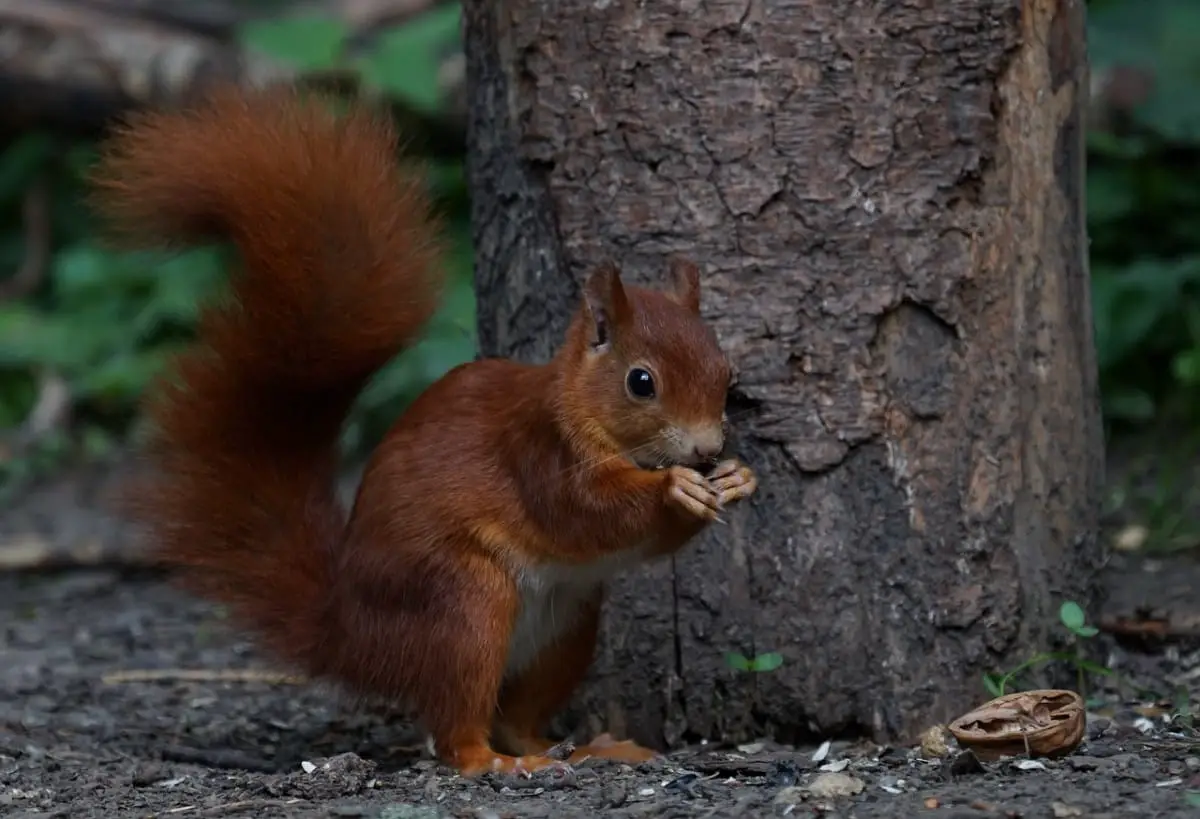
Red squirrels are not known to carry any diseases that are harmful to humans, although, like most wild animals, they are prone to picking up parasites on their fur – mainly lice, ticks and mites – and they can easily catch fleas, to the point where they frequently have to abandon their nests due to flea infestations.
As far as catching diseases goes, they are very likely to suffer from squirrel pox if brought into close proximity to greys. They can even pick up the disease from domestic squirrel feeders that greys have previously used, which is why it is so important to ensure garden feeders are kept as clean as possible using an animal-friendly disinfectant like Virkon S (Amazon link).
Other common diseases include adenovirus and leprosy. Since adenovirus primarily affects the digestive system, it exhibits no external symptoms, and animals can frequently carry it without exhibiting any symptoms at all.
It’s still a relatively new virus as far as research goes, so the long-term effects on Britain’s red squirrel numbers are unknown. It is almost impossible to eradicate because rats and mice also carry it.
Leprosy is a fairly new discovery in red squirrels, but current research suggests it has existed in populations for hundreds of years. The only ‘good’ thing about leprosy is that it takes a long time for the disease to take hold, so the animal normally dies of natural causes before leprosy gets a chance to run its full course. If you see a red squirrel with what looks like warts around its ears, it’s probably suffering from leprosy but isn’t likely to have any other ill effects from it.
Facts About Red Squirrels
1: Red squirrels are known for their colour although it can vary dramatically between animals with even those from the same litter having coats that range from a wheat colour to dark brown. Whatever their colour they always have the same white fur on their underbelly.
2: Although they live longer than their grey cousins in the wild, with females averaging six years, in captivity they have been known to live for up to ten years.
3: Red squirrels are unable to digest unripe nuts so they have developed a powerful sense of smell that allows them to detect whether a nut is suitable for eating without having to crack it open first. They can even sense whether a nut has gone off inside its shell and they can locate nuts buried up to a foot in the snow.
4: Just like people, squirrels can be left and right-handed and even ambidextrous! Studies have shown that a right-handed squirrel will hold a pine cone with the top pointing towards the right and then use their right paw to rotate it around as they pick out the seeds, and vice versa for left-handed animals.
5: Red squirrels do not pair for life and will change partners regularly during each breeding season. This helps them spread their genetics around which is a useful trait for an animal that only has a 50% chance of surviving its first year.
6: While grey squirrels can be culled in order to keep numbers down it is an offence to inflict any cruelty on them or hold them captive in any way. The law in Britain is even stricter for red squirrels and it is an offence to cause any harm at all to a red squirrel under the Animal Health and Welfare Act 2006.
7: Red squirrels are double-jointed. They developed this handy trait to enable them to zoom up and down trees with enough speed to easily outrun predators as well as cling onto the thin branches on the very highest treetops.
8: Although the average red squirrel is only a little over 20 cm when standing upright they can jump up to 200 cm which is the equivalent of a human jumping 14 metres in a single bound.
Book Tours in Scotland
Resources
- One unfortunate aspect of wildlife-watching in the west of Scotland is having to deal with the infamous midge. Learn how to stop getting eaten alive with this guide – How to Avoid Midges in Scotland – The Complete Guide.
- Arran is an often-overlooked place to spot red squirrels but due to the fact there are no greys there the number of reds is growing steadily. You’ll find lots of information about Arran in my Guide to Arran Forest Walks.
- The official online resource for Scotland’s forests is the Forestry and Land Scotland website.
- Find forest paths and woodland walks with Ordnance Survey maps. Buy OS Landranger maps direct from Ordnance Survey.
- If you spot a red squirrel please record your sighting at the Saving Scotland’s Red Squirrels website.
- Discover more information about Scottish wildlife on the Scottish Wildlife Trust website.
Frequently Asked Questions
Are there any red squirrels in Scotland?
Although under threat in Britain, there are many places in Scotland where red squirrels are thriving.
Current numbers are estimated to be between 120,000 to 140,000 animals in the wild.
Where do red squirrels live in Scotland?
Red squirrels prefer to live in mixed woodlands but due to a loss of habitat they have been pushed into mostly coniferous forests.
They can be found in Scotland’s six forest parks which are; Argyll Forest Park, Galloway Forest Park, Glenmore Forest Park, Tay Forest Park, Tweed Valley Forest Park and Queen Elizabeth Forest Park.
Are red squirrels friendly?
Red squirrels are quite skittish and much faster moving than slower and bulkier grey squirrels.
Red squirrels are considered to be slightly more aggressive than greys so it is not wise to try to touch or pet them as they will likely bite in defence.
Are red squirrels protected in Scotland?
Red squirrels are protected in Britain. They receive full protection under the Wildlife and Countryside Act 1981 and it is an offence to:
1. Kill, injure or take a red squirrel.
2. Damage, destroy or obstruct access to a drey or any other structure or place which a red squirrel uses for shelter or protection.
3. Disturb a red squirrel when it is occupying a structure or place for shelter or protection.
Protect Your Family From Scotland's Biting Midges
- Powerful, reliable protection for up to 8 hours
- Water- and sweat resistant
- Repels midges, mosquitoes, horse flies, sand flies, fleas and ticks
- Safe for use on adults, children over 30 months and pregnant women
- Non-sticky, moisturising with a pleasant fragrance
- Packaging may vary



